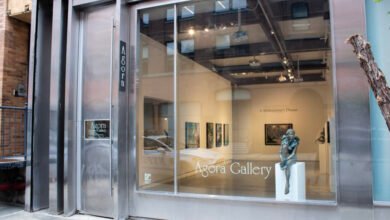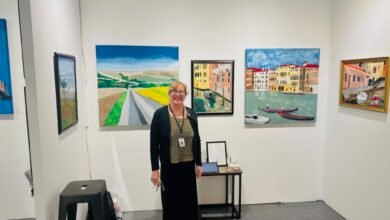
Have you ever discovered an art exhibition in a place you wouldn’t expect, like an old warehouse or an empty retail store? These are known as pop-up galleries—temporary art spaces that inject fresh creativity into unusual environments. Untethered to any fixed location, the nomadic nature of pop-up galleries means that they can emerge anywhere, revitalizing spaces that have been overlooked. This innovative approach surprises and delights art lovers but also garners attention in the art industry, capturing the interest of those who follow cultural trends.
The Evolution of Pop-Up Galleries
Pop-up galleries have quickly become a beloved trend in the art world. Originally, these spaces were makeshift solutions for artists to showcase their work without the commitment of a permanent gallery. Today, they serve as innovative platforms for artists and curators to experiment with their surroundings and presentation styles. During the last decade, temporary galleries have hosted many new exhibits worldwide, indicating a shift in how art is consumed and appreciated.

Photo courtesy of Jessica Pamp for Unsplash
These Galleries Are Experiencing a Boom
Pop-up galleries are transforming the art market landscape by offering flexible and cost-effective alternatives to traditional art fairs. According to Artsy.net, dealers reported that 46% of their sales by value occurred at art fairs. However, the costs associated with these fairs are substantial, with dealers spending approximately $4.8 billion in 2018, an increase of 5% from the previous year. This financial strain is pushing many galleries to explore innovative models like pop-ups. These temporary spaces reduce overhead costs and allow for creative engagement with new audiences. As a result, pop-up galleries are becoming an increasingly popular choice, especially among small to mid-sized galleries seeking to maintain visibility and viability in a competitive market.
Cultural and Artistic Impact
The nomadic nature of pop-up galleries has reshaped the art landscape by offering a platform for unconventional and emerging artists. These spaces often allow for riskier, more experimental works that might not find a home in traditional galleries. By doing so, they challenge artists and audiences to rethink art’s role in society. In the bustling U.S. art market, pop-up galleries have also become a crucial venue for diversity, showcasing artists from various backgrounds who might not otherwise receive gallery representation.
Advantages of Pop-Up Galleries
These galleries offer several unique benefits that are reshaping the art scene.
Flexibility
Their flexibility allows them to occupy any space available, from a park corner to an abandoned building, making art accessible in places you’d least expect. This adaptability benefits artists by providing various contexts to display their work and engaging a broader audience.
Catering to Current Events
Another significant advantage is their ability to quickly set up in response to current events, providing a platform for artists to comment on real-time issues. This immediacy can make art feel more relevant and connected to everyday life.
Boosting Neighborhoods
By nature, pop-up galleries can rejuvenate underutilized spaces, adding value to neighborhoods and encouraging community interaction. They often create a buzz, attracting locals and tourists alike who are eager to experience art in novel settings. Such dynamic environments can dramatically increase foot traffic, which benefits local businesses and boosts economic activity in the area.
Challenges Faced by Pop-Up Galleries
While the nomadic nature of pop-up galleries offers unique opportunities, they also come with their own set of challenges.
Funding
For starters, the transient nature of these galleries can make it difficult to secure funding. Investors often hesitate to put money into ventures that might seem temporary or unstable. This funding challenge is exacerbated by the logistical complexities of setting up exhibitions in non-traditional spaces, particularly when transporting priceless masterpieces. Ensuring the safety and security of these artworks, often in spaces not originally designed for such displays, requires careful planning and significant resources.
Permanence
Another significant hurdle is the lack of permanence, which can affect how audiences perceive these galleries. Since pop-up galleries do not have a fixed location, maintaining a consistent visitor base can be tricky. Art lovers might visit once or twice, but it’s hard to build long-term visitor relationships without a permanent address. Additionally, this impermanence can impact artists’ ability to gain sustained exposure.
Impact on Community Engagement
However, these challenges do not dampen their vital role in community engagement. They often act as catalysts for local development, sparking interest and bringing people together in underutilized spaces. Here are a few ways these galleries positively impact communities:
- Boosting local economy: Temporary exhibitions attract visitors who are likely to spend money at nearby businesses.
- Enhancing community spaces: Pop-up galleries help beautify and revitalize neighborhoods by occupying vacant or underused properties.
- Encouraging cultural dialogue: They provide a platform for artists to engage directly with diverse audiences, promoting inclusivity and understanding.
Despite these benefits, the unpredictability of operating in ever-changing venues remains intimidating for many organizers.
Future Trends
The future of these galleries seems promising, driven by their ability to adapt and innovate. Emerging technologies like virtual reality and augmented reality are beginning to play a role, allowing for digital exhibitions that can reach a global audience without the need for physical space. This technological integration solves logistical issues and opens new possibilities for interactive and immersive art experiences.
Moreover, there is a growing trend of pop-up galleries upholding handcrafted family traditions by featuring artisanal and locally crafted works. This supports local artists and preserves cultural heritage, making these temporary galleries a crucial part of the art ecosystem.

Photo courtesy of Sincerely Media for Unspalsh
Steps to Launch a Successful Pop-Up Gallery
Setting up a pop-up gallery requires careful planning and strategic execution. Here are some ways to approach the task:
- Establish clear goals, such as reaching new audiences or testing a market.
- Choose a location that aligns with your target demographic and consider timing your opening with major art events to maximize foot traffic.
- Negotiate terms that suit your budget and ensure the space meets all necessary legal requirements.
- Prepare a detailed budget, accounting for rent, utilities, and staffing.
- Focus on art and community engagement, possibly outsourcing daily operational tasks to concentrate on sales and artist relationships.
Final Thoughts on the Nomadic Nature of Pop-Up Galleries
The nomadic nature of pop-up galleries makes them more than just temporary art spaces. They are dynamic platforms that challenge traditional norms and encourage innovation in the art world. While they face various challenges, their benefits make them invaluable. As we move forward, these nomadic galleries will likely continue to evolve, further impacting artistic expression and community engagement in profound ways. Their ability to adapt and transform makes them an enduring part of the contemporary art scene, continually bringing art closer to the people.
__________________________
Author bio:
Ella Marquez works at a logistics and moving company, Logicstics, an expert in the field whose track record of excellence and forward-thinking approach has earned the trust of numerous businesses in various industries. Ella loves exploring innovative art trends and gallery movements worldwide.
Source link



